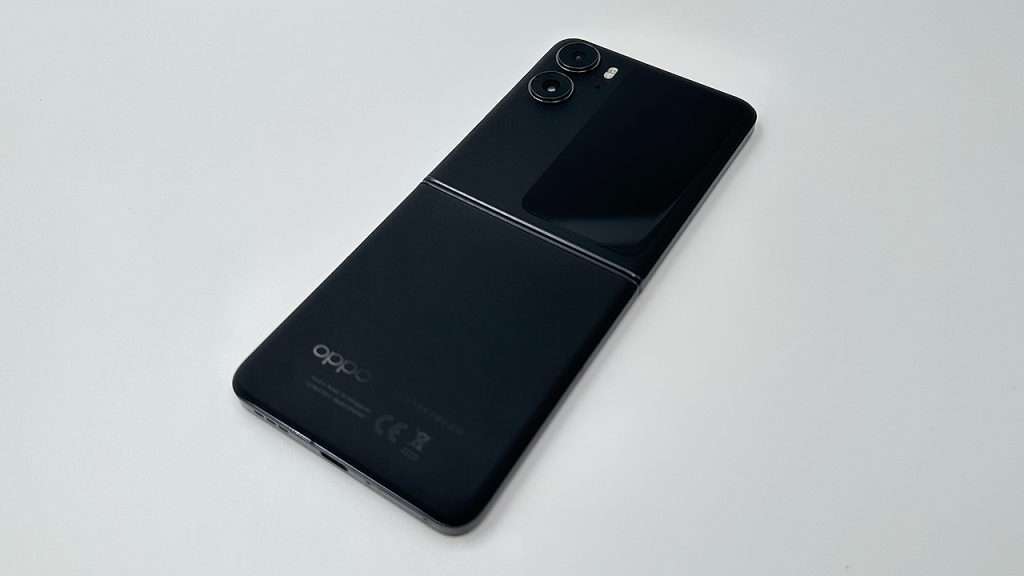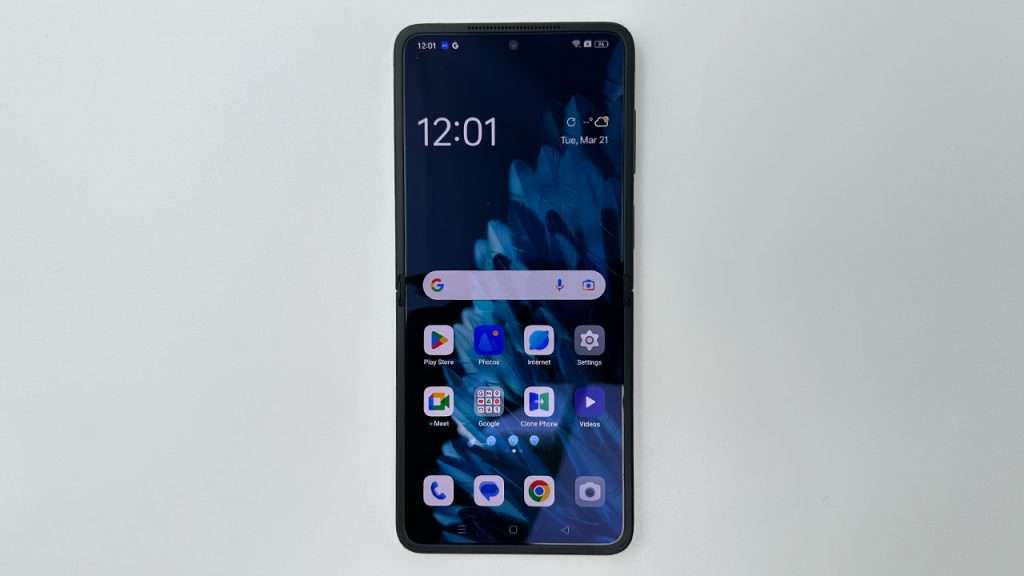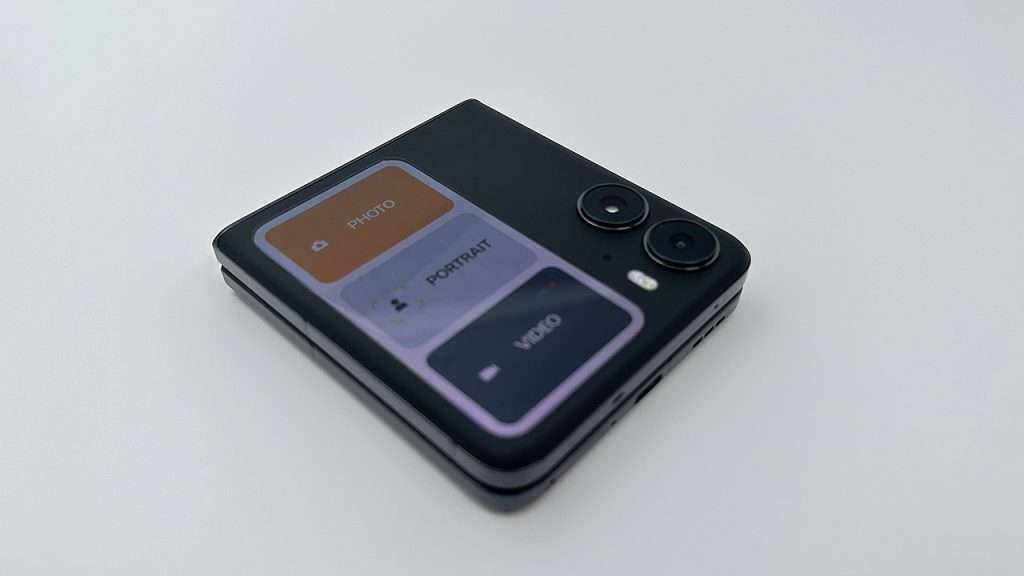Let’s get the obvious out of the way, the key feature of the Find N2 Flip is the hinge. If you don’t like a foldable phone, this isn’t going to be for you. If you do, it’s nice to have another option other than the Samsung Galaxy Z Flip range, but once you get past the hinge, there isn’t a lot of innovation here.
The benefits of a foldable device are well documented, you can fold it like a laptop and sit it on a flat surface and you can fold it into a smaller form. There’s also a front display so you don’t have to unfold the device to use it.
In this regard, the N2 Flip works well. The front display is large and easy to use thanks to its vertical orientation, it’s easy to fold, it’s sturdy and the apps compatible with FlexForm mode – in which you orient the phone like a laptop – work well.
But there isn’t a lot here to set it apart from its main competitor the Samsung Z Flip4. The most attractive feature of the Find N2 Flip is it’s cheaper than the Z Flip4 but these devices are so similar that you’ll get the same experience with either of them.
Still, like the Z Flip3 – Samsung hasn’t sent theBit a Flip4 for testing – there isn’t enough here that makes me want a foldable over a non-foldable. Not many apps are compatible with FlexForm, there’s only a few widgets available on the front screen, the camera array and performance is average at best, and the battery is a little disappointing.
There are numerous non-foldable devices that are better in every way except obviously, they don’t fold.
Pros
- Waterdrop Flexion Hinge
- Great price
- 44W charging
- Size of the front display
Cons
- Not much innovation
- Front display lacks functionality
Price
The Find N2 Flip costs $1,679 for an 8GB RAM and 256GB of internal storage model.
This is a great price seeing as Samsung’s Galaxy Z Flip4 costs $1,849 for an 8GB RAM, 256GB model and Apple’s iPhone 14 Plus costs $1,999 with 256GB of storage.

Design
Unfolded, the N2 Flip measures 166.2 x 75.2 x 7.5mm and folded it measures 85.5 x 75.2 x 16mm. It’s a thin, light device that can easily fit in a pocket or a bag when folded.
On the back there’s a dual-camera array and it comes in two colours, Astral Black and Moonlit Purple. They’re both fine.
The Find N2 Flip boasts what Oppo calls a Waterdrop Flexion Hinge. This allows the device to sit flush when folded, there’s no gap between the top and bottom halves which means debris, dirt, and pocket lint won’t get in between the faces. This is an issue with other foldables and while it seems minor it’s a welcome improvement.
Oppo has found a good balance between the hinge being sturdy whilst not being a burden to use. It’s easy to fold and unfold the device and I could easily do it with one hand. Oppo claims the hinge has been tested to last up to 400,000 folds which is decent.
On the front there’s a 3.26-inch with a 9:17 aspect ratio cover screen. It’s large and easy to use and its vertical orientation adds to the functionality. I found it easier to reply to texts and use widgets with just the front display than any other foldable I’ve used. Annoyingly when holding the device unfolded, my index finger would rest on the bottom of the cover display. It didn’t feel right, and I often found I would move my grip into an unnatural position to avoid this.
The device boasts Gorilla Glass 5 and I praise Oppo for including a protective case in the box, however the clear case looks ugly. It’s a nice touch but you’d be better buying a dedicated case for $60. They look much better.
You’ll probably want a case as well because the Find N2 Flip doesn’t boast any kind of resistance rating. This is frustrating especially as most devices these days now boast some sort of resistance rating. The Z Flip4 boasts an IPX8 rating, making it water-resistant up to a depth of 1.5 meters for 30 minutes.
Display
The Find N2 Flip boasts a 6.8-inch, FHD+ 2520×1080 120Hz main display. And a 3.26-inch, 720×382 60Hz cover display.
The main display is good. Videos and images look fine and the 120Hz refresh rate is smooth. It supports a peak brightness of 1600 nits and it uses LTPO technology to adjust the refresh rate to conserve battery. Able to drop as low as 1Hz.
The crease is relatively unobtrusive. I only noticed it when I went looking for it. Looking down on the phone, you can more easily see the crease, but it wasn’t an issue.

Features
The front display is compatible with a number of widgets, you can reply to texts with it, check the weather, quickly take selfies and even raise a “Tamagotchi” type digital pet.
I would’ve liked more functionality here. Currently, there’s only a small number of widgets available, and there wasn’t enough support from third-party apps. I wasn’t able to control music, I could only see the subject line of received emails and other than replying to messages, there wasn’t enough functionality to stop me unfolding the device. Other than taking photos, I could do more with my smartwatch.
Taking photos is where it was most beneficial. Inside the camera app you can turn on “cover screen preview” in which the subject can see themselves in the front display. For someone like me who struggles to smile naturally for photos, I enjoyed being able to see myself and adjust what I was doing. Similarly it was significantly easier to take photos of my young niece and nephews who enjoyed looking at themselves in the display.
The hinge allows for what Oppo calls FlexForm mode in which you can fold the top screen up 90° like a small laptop. It allows you to place the phone on a surface and take selfies, you can hold the phone sideways like you’re using an old handheld camera, you can take and make video calls and even watch YouTube with the comments on the bottom half of the screen and the video on the top. I particularly enjoyed being able to place the device on my car dashboard and watch videos, I didn’t have to hold it the entire time. But once again not enough apps are compatible with this mode.

Performance
The Find N2 Flip has a 5G MediaTek Dimensity 9000+ CPU inside.
For a more detailed look into the N2 Flip’s capabilities, we ran a Geekbench 6 CPU test to measure the speed of the device’s CPU and a 3DMark Wild Life Extreme Unlimited test to measure the performance of the processor’s 3D graphic rendering and CPU workload processing capabilities.
We then compared that to the Samsung S23 Ultra. Bear in mind, the S23 Ultra is a significantly more expensive device with a much more powerful chip but it gives us an idea of how the Find N2 Flip compares to a flagship Android device:
| Geekbench 5 results | Single-core | Multi-core |
| Samsung S23 Ultra | 1568 | 4892 |
| Oppo Find N2 Flip | 1068 | 3227 |
| 3DMark Wild Life Extreme Unlimited | Score | Frames |
| Samsung S23 Ultra | 3799 | 22.8fps |
| Oppo Find N2 Flip | 2644 | 15.8fps |
These results are pretty good.
The N2 Flip will handle normal usage like scrolling through social media, taking photos and watching videos. You’ll also be able to play graphically intensive games, however it’s not as fast as other chips out there and more intense usage like video editing will cause slowdowns.
Cameras
The N2 Flip boasts a dual camera array. There’s a 50MP, f/1.8 wide and an 8MP f/2.2 ultrawide.
Similar to the 12MP f/1.8 wide and 12MP f/2.2 ultra-wide found on the Samsung Galaxy Z Flip4, this is a midrange array. If you’re looking for a phone that’s going to take the best photos this isn’t it. It’s a bit disappointing seeing as the Samsung Galaxy S23 has the same starting price and a much better camera array.
Below, we’ve compared the Find N2 Flip with the Samsung S22 which has a 50MP f/1.8 main, 10MP Telephoto with 3x optical zoom and a 12MP ultrawide:
You can see from these images, that the S22 does a better job of representing realistic colours. The Find N2 Flip image has a blueish hue to the image.
When comparing the devices at 3x zoom, the Find N2 Flip is able to produce a sharper image. We can see clearly if we look at the light on the left of the image. It’s sharper and better defined.
Here we can see the benefits of a dedicated telephoto lens. The S22 boasts a 10x telephoto lens meaning it isn’t using software to create pixels at this zoom level. The Find N2 Flip doesn’t have a 10x telephoto lens and is reliant on software predicting the pixels. The end results are drastically different. The S22 produces a much sharper, more detailed image at 10x zoom.
In low light situations both devices do a good job of lighting the subject. The Find N2 Flip image is a bit brighter.
When you fold the device you can take selfies with the 50MP wide camera. This is a nice touch and being able to see yourself on the front screen works well. However, I didn’t notice much difference between images taken with the front camera and the selfie camera.
One thing I didn’t like was the placement of the cameras in regard to the cover display. As a right hander often, my hand would get in the way of the cameras. This meant facial recognition unlocking wouldn’t work until I moved my hand and similarly, I had issues when trying to take selfies.
The screen prompts you to rotate the phone when taking a selfie; however that’s two movements – folding the device, then rotating it – just to take a picture. This is something I wouldn’t have to do with a non-foldable device and it got annoying quickly.
Battery
The 4,300mAh battery inside the Find N2 Flip is a little disappointing. It’s bigger than the 3,700mAh battery in the Z Flip4 however I still couldn’t quite get a full day’s use of it with moderate usage.
With heavy usage like taking photos and gaming, the battery life decreased dramatically requiring at least one charge in the middle of the day.
The one saving grace is the battery charging speed. Oppo has maintained its trend of including a charger inside the box. This is a trend I like and the 44W charger that comes with the Find N2 Flip will charge the device to 50 percent in around 20 minutes and to 100 percent in 55. It’s significantly faster than other devices out there; you’ll just have to take a charger around with you. Not ideal.

Verdict
If you’re looking for a foldable device, Oppo’s Find N2 Flip is a good option. It’s cheaper than the only alternative we have here in NZ, Samsung’s Galaxy Z Flip4 and it boasts a better battery.
But foldables have a long way to go before they compete with non-foldable devices.
While the Find N2 Flip competes with the Z Flip4 it doesn’t compete with non-foldable devices in the same price range. Samsung’s S23 has a better camera array and better performance.
The only standout features of the N2 Flip are the front display and its ability to fold. But even then, there are only a handful of apps that truly utilise its foldability and I barely had any use for the front display other than replying to messages.
I can still quite easily fit a non-foldable phone in my pocket and I’ve never needed to prop my device on a surface to film myself. Then again, I’m probably not the target audience…
If you’re looking for a foldable device that can make it easier to take selfies and selfie videos, you’ll love the Fold N2 Flip, but if not, there are much better devices out there, with the caveat being, they don’t fold.

